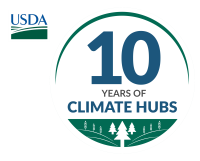Just over a decade ago, the USDA Climate Hubs were announced. I happened to be in the room where the Northeast Climate Hub would be hosted. On a detail with the Northern Research Station at the time, I was seeking a new opportunity after 17 years with the Forest Service National Forest System.
Hearing that the Northeast Hub would need some help, I jumped at the chance. Along with Director Dave Hollinger and Co-Director Lindsey Rustad, our thus-far forestry-focused careers were about to pivot with the new challenge ahead of us. Together, we set out with a mission to deliver usable science to meet the needs of both forestry and agricultural producers as they deal with intensifying climate change.
Regional Hubs for Risk Adaptation and Mitigation to Climate Change were created to address the risks posed by climate change to working lands. First named in Obama’s Climate Action Plan, the establishment of these Climate Hubs showed progress in the goal to maintain productivity through delivering science-based knowledge to forest landowners, natural resource managers, ranchers, and farmers to help them understand and prepare for the effects of climate change. The Climate Hubs were established to support decision-making on working lands.
Recognizing the importance of using evidence-based decision support, Secretary of Agriculture Tom Vilsack placed the ten regional Climate Hubs within Research-focused sectors of USDA. This included USDA Forest Service Research and Development and the Agricultural Research Service (ARS); both at the forefront of science and technology relating to working lands and climate change.
Leveraging the varying strengths of agencies within USDA, we quickly built a team with co-leadership in ARS and the Natural Resources Conservation Service (NRCS). The Climate Hubs embodied “OneUSDA” and this comradery is still our favorite way to describe the way we work across agencies. The priority for our Hub - and my first task as Coordinator - involved developing connections and partnerships. In the first year we identified key people at the Northeast’s Land Grant Universities who were already working with farmers and forest producers to address challenges they face, including the changing climate. The decade-long relationship these connections formed serve as the backbone to the Northeast Climate Hub’s work. It makes sense to work together as we aim to build the resilience of our farms and forests.
Over the years our mission has stayed true, while our priorities have shifted and expanded.
We work across the agencies within USDA and with partners toward our vision of healthy forests, robust agriculture, and resilient communities. As we increase understanding of regional vulnerabilities and adaptation strategies, we have developed science-based solutions. These include tools and resources that aid climate-informed decisions. This approach is leading to changes in the way working lands are managed. As more decisions are informed by climate science, the outcome is increased resiliency and productivity on our landscapes. Climate mitigation—reducing greenhouse gas emissions and increasing carbon sequestration—has always been part of the Climate Hub’s mission. This work will increase in the coming years as we contribute to Inflation Reduction Act to help more forest managers and agricultural producers adopt climate-smart practices.
Two achievements stand out as I reflect on a decade of work—the team we built and our impact on climate resilience.
In 2014, we had no full-time Climate Hub staff. And while it took most of the last ten years, our regional hub is now a collaborative cross-functional team of over 20 scientists and communication experts, composed of federal employees, fellows, and partner-supported staff. The need for incorporating climate science and adaptation solutions into planning and management has grown, as the challenges related to climate change grow. A leading example of our work to deliver climate resilience information is through contributions to the Fourth and Fifth National Climate Assessments (NCA). These accessible and broadly read publications increase awareness about the impact of climate change to our region and the sectors we care about. The Northeast is making significant progress in line with the NCA, by actively developing and implementing strategies for climate adaptation and mitigation.
Much work lies ahead.
The team at the Northeast Climate Hub continues to strive to keep up with the increased workload and growing expectations from USDA, our partners, and the people we serve. We feel honored that the Climate Hubs are acknowledged 250 times in USDA agency climate adaptation plans, and this indicates that the responsibility to serve has increased. Climate change is a complex issue that needs ‘all hands’ to find solutions. The Hubs are well positioned to convene the key partners and resources and to develop strategies to promote climate-informed decision-making. As a whole, we maintain resilience and flexibility to changing challenges and resources. With addressing climate change as a top priority of the Administration and the USDA, we are showing up for the assignment. As the Climate Hubs celebrate ten years of service, I reflect on what we have built and am optimistic that the Climate Hubs are prepared for what lies ahead.
Image

More Information
For more information on the Climate Hubs’ mission and resources, please visit our website and learn what climate-focused information is available by region, or view a summary of our most notable work, over the last decade.

